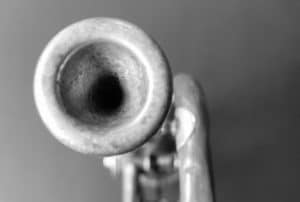Experiencing problems with a sticky trumpet valve or other valve parts and components is a common part of owning your instrument, but many problems can be fixed with ease.
Trumpets require many components that work together in order to function properly. Unfortunately, many of these parts can suffer from issues that affect play. Some of the problems with these parts may even affect the way other components of the trumpet function.
After playing for a while, you may experience a variety of problems with the trumpet valves such as sticking. Parts such as slides and valves are movable, so their proper functioning is a priority. Movable parts will likely tend to cause more problems than those that are stationary, and such issues are completely normal.
In contrast, the mouthpiece can be removed, but it does not move when played like the other parts. There are several ways to fix common functional issues with your trumpet.
Missing Buttons
Missing trumpet valve buttons may be a problem for those that buy vintage trumpet models. You can often buy new ones online or where you find other trumpet repair parts. It is best to have trumpet buttons replaced by a professional.

Sticky Valves
One of the most common issues with valves is sticking. Valves are meant to move up and down smoothly to facilitate good playing, but sticky valves may get stuck at certain places and are slow coming up again.
This usually happens as the valves get stuck midway through pressing or just as they are about to be pressed. Sticking valves will make it difficult to play in addition to ruining your sound, so you’ll want to unstick your valves sooner rather than later.
The best way to handle sticky trumpet valves is to keep the valves well lubricated with good quality valve oil. If you practice every day, you should oil the trumpet’s valves at least once each week. Those that play for long periods each day will need to oil the valves more frequently.
Blue Juice valve oil is a great valve oil, and it is highly recommended for frequent players. Luckily, valve oil is generally inexpensive and one bottle will last you for a very long time.
- fast acting oil
- long lasting
- helps to keep horns clean internally
- fast acting oil
- helps to keep horns clean internally
How to Oil Trumpet Valves
If you are not accustomed to oiling your own trumpet valves, you can perform the following steps to get through the process more smoothly. Oiling the valves is not difficult, but it is still wise to keep a few tips in mind when doing so.
Younger players without experience would be better off seeking the assistance of parents on instructors before beginning. Parents of young trumpet players should be accustomed to the steps of oiling the valves as well as simple trumpet valve repair techniques.
Follow these steps to oil trumpet valves the easy way:
1. Lie the trumpet on a flat surface.
2. Unscrew the first valve slide.
3. Slide the valve out slightly.
If the valve is pulled out completely, it is more likely to be dropped and damaged. It could also get put back in the wrong way.
Make sure to pull only one slide out at a time so that they are not mixed up.
4. Place a few drops of oil on the shaft of the valve.
Make sure you don’t drip the oil in the holes but on the valve shaft.
5. Slide the valve back in.
Listen for a clicking sound. Once you hear the click, tighten the valve cap again. And you’re done!
Potential Problems That May Occur After Oiling
The trumpet can’t be blown.
This is likely due to having placed the valve in backwards. It can be fixed by pulling the valve back out and checking to ensure the number engraving is pointing in the direction of the mouthpiece.
The valves are too sticky.
This can occur if the oil has caused debris to loosen in the trumpet valve case. It can be fixed by pulling the valve out and thoroughly wiping it with a clean cloth. It will then need to be oiled again before being re-inserted. It may also be helpful to remove the bottom valve cap to clean the valve casing.
See also: How to Clean a Trumpet
Looking for a teacher?
Want to get lessons at the comfort of your own home? Check out the course Learn to Play the Trumpet: Beginner to Pro Made the Easy Way* on Udemy! (See their full trumpet course line-up here*!)
Air Leakage
New trumpets don’t usually have many issues, but those that are used frequently over time may suffer from leaking valves. Valves that are loosely held in the casing will allow air to leak out between the valve and casing, and this will affect the instrument’s response. Leaking valves usually occur once they wear down over time with consistent use.
A valve that is extremely loose can be an even greater concern as it can bind within its casing. Using a heavier valve oil can help to reduce air leakage from loose valves, but it is usually better to have valve work or a replacement performed. Even if you have access to trumpet replacement parts, such tasks should be done by an expert.
Stuck Mouthpiece
If your mouthpiece gets stuck, the best way to get it unstuck is with a mouthpiece puller*. They’re a one-time investment that will help you remove stuck mouthpieces without damaging your trumpet. Also, see these three methods of getting your mouthpiece unstuck for some more inspiration.
Stuffy Sound
An airy or stuffy sounding instrument is a common occurrence that is likely related to the trumpet’s valves. You can often find and eliminate the problem by checking the following five scenarios:
1. Check the valve condition
Check the valves to ensure none of the corks, felts or spacers are worn down or missing.
2. Check the water key
Make sure the water key is not broken or leaking. If the cork for the water key is missing or worn down, the seal will not be secure. This can create a stuffy or airy sound. Also check for a broken or missing water key spring, and check to see if the water key is bent.
3. Check the valve order
Make sure the valves have not been mixed up as this can often happen after cleaning the trumpet. The valves are numbered 1 to 3, and the first valve should be in the valve casing closest to the mouthpiece. The second valve should be in the center position, and the third valve should be closest to the bell.
4. Check the valves
Check to see if anything is stuck in the trumpet. Pull the slides and valves out and pass a cleaning snake through all of the trumpet’s tubing. You can purchase cleaning snakes specifically for trumpet use.
5. Check for air leakage
Check for air leakage. A compromised trumpet body is rare, but sometimes there may be broken welds or very small holes caused by corrosion. Such circumstances can allow air to escape.
TrumpetHub.com is a participant of the Amazon Services LLC Associates Program, an affiliate advertising program. Links marked with an asterisk (*) are affiliate links. If you buy a product through an affiliate link, we will get a small commission without extra cost to you. This helps us earn an income off the free content we provide to you. Thank you for your support!







